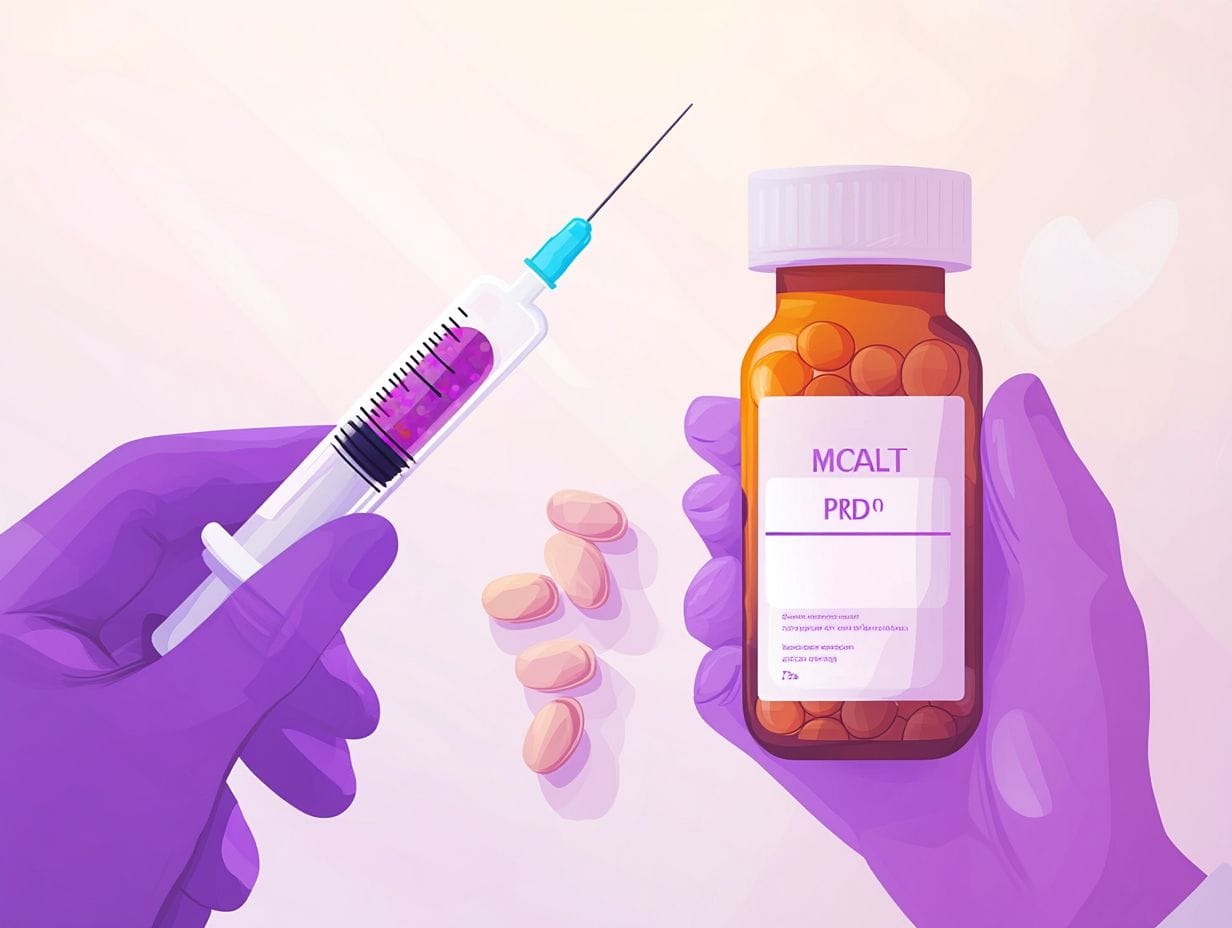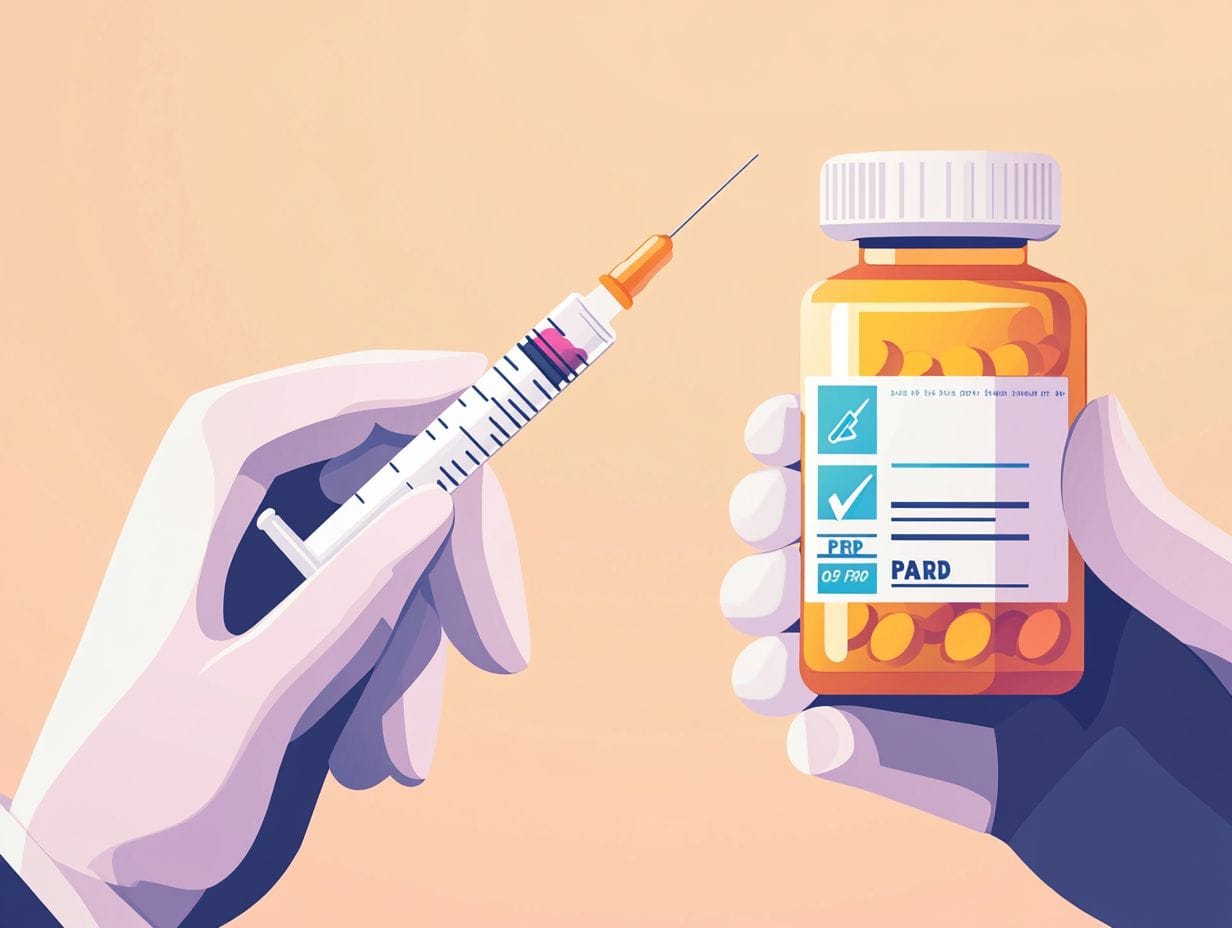Hair loss can be a distressing experience, impacting self-esteem and overall well-being.
Understanding the various causes and types of hair loss is the first step toward finding effective solutions.
This article explores two popular treatment options:
- PRP (Platelet-Rich Plasma) therapy
- Hormonal treatments
We examine how each method works, their effectiveness, and how they can be combined for enhanced results.
By the end, you will have the insights needed to choose the best approach for your hair restoration journey.
Understanding Hair Loss

Hair loss is a prevalent condition that impacts millions of individuals globally, resulting in various emotional and psychological challenges. A comprehensive understanding of hair loss necessitates an examination of its numerous causes, which can range from genetic factors, such as androgenetic alopecia, to lifestyle influences including stress, diet, and hormonal imbalances.
This complex issue often demands an in-depth understanding of the various types of hair loss, such as telogen effluvium, scarring alopecia, and the effects of androgens like DHT. Additionally, hair loss statistics underscore its prevalence and significance in contemporary society, emphasising the need for effective treatment options.
Causes and Types of Hair Loss
Hair loss can be classified into several types, each associated with distinct underlying causes, including hormonal changes, genetic predispositions, and lifestyle factors. Androgens, particularly dihydrotestosterone (DHT), play a critical role in conditions such as androgenic alopecia, whereas conditions like telogen effluvium arise from stress or hormonal treatments.
A comprehensive understanding of these types is essential for effective hair restoration, as different conditions impact the hair growth cycle and its phases, such as the anagen phase.
Plus androgenic alopecia and telogen effluvium, other forms of hair loss include alopecia areata, an autoimmune disorder in which the body mistakenly attacks hair follicles, resulting in sudden hair loss.
Factors such as thyroid imbalances and nutritional deficiencies can exacerbate these conditions, disrupting the normal hair growth cycle. Furthermore, genetic factors significantly influence an individual's susceptibility to hair loss, underscoring the necessity for personalised assessment.
Hormonal treatments, including those aimed at balancing oestrogen and progesterone levels, may help mitigate certain types of hair loss, enabling affected individuals to explore tailored options that address their specific needs.
PRP Treatment for Hair Loss
Platelet-Rich Plasma (PRP) treatment has gained recognition as a prominent non-surgical solution for hair restoration, leveraging the body's intrinsic growth factors to facilitate follicular regeneration.
This advanced therapy involves drawing blood, processing it to concentrate the platelets, and subsequently injecting the PRP solution directly into the scalp.
The growth factors contained within the platelets are believed to stimulate hair follicles and improve scalp health, making PRP a viable option for individuals experiencing various forms of hair loss.
What is PRP and How Does it Work?
Platelet-Rich Plasma (PRP) is a medical treatment that leverages the body s inherent healing properties to rejuvenate hair follicles and stimulate hair growth. The procedure begins with a standard blood draw, followed by centrifugation to separate the platelets, which are abundant in growth factors vital for cellular repair and regeneration. Once prepared, the PRP is injected into the scalp, specifically targeting areas affected by thinning hair or baldness. This process ideally requires the expertise of a medical professional to ensure optimal results.
This innovative approach not only enhances hair density but also improves overall scalp health by utilising the body s natural resources. The growth factors present in PRP are instrumental in activating hair follicles, facilitating new hair growth while extending the lifespan of existing hair.
By promoting cellular activity in the targeted regions, PRP enhances blood circulation and revitalises hair roots, contributing to a fuller head of hair.
It is essential to consult a qualified specialist prior to undergoing any treatment to customise the procedure according to individual needs and to maximise its effectiveness.
Effectiveness of PRP for Hair Loss

The effectiveness of Platelet-Rich Plasma (PRP) treatment for hair loss has been substantiated by various clinical studies, which indicate promising results in terms of hair regrowth and patient satisfaction. Research demonstrates that numerous patients experience increased hair density and thickness following PRP therapy, with some achieving significant long-term outcomes. Its efficacy is frequently compared to traditional treatments such as minoxidil and finasteride, positioning PRP as a viable non-invasive option for individuals experiencing hair loss.
In these studies, patients have reported a higher satisfaction rate with PRP, emphasising its natural approach to stimulating hair follicles. Unlike some pharmaceutical alternatives that may present undesirable side effects, the safety profile of PRP is generally favourable, characterised by minimal downtime and discomfort. For those considering their options, exploring topical solutions vs. oral medications can provide valuable insights into the best treatment for hair loss.
As interest in alternative solutions grows, an increasing number of practitioners are incorporating PRP therapy into their hair restoration practices, highlighting its potential to enhance overall results. The combination of clinical data and positive patient feedback reflects a shift towards recognising PRP not merely as an alternative, but potentially as a leading choice in contemporary hair restoration.
Hormonal Treatments for Hair Loss
Hormonal treatments for hair loss have garnered significant attention for their effectiveness in addressing underlying hormonal imbalances that contribute to conditions such as androgenetic alopecia and telogen effluvium.
These treatments may encompass hormone replacement therapy or medications designed to regulate testosterone and oestrogen levels, potentially playing a vital role in restoring hair growth for individuals affected by hormonal fluctuations.
It is essential to understand the various hormonal treatments available in order to develop a personalised treatment plan that effectively meets specific hair restoration needs.
Types of Hormonal Treatments
There are several types of hormonal treatments available for hair loss, including finasteride, minoxidil, and hormone replacement therapy, each targeting specific hormonal pathways. Finasteride functions by inhibiting the conversion of testosterone to dihydrotestosterone (DHT), a key factor in hair follicle miniaturisation associated with androgenic alopecia.
Minoxidil, although not a hormonal treatment, is frequently utilised in conjunction with these therapies to enhance blood circulation to hair follicles, thereby improving overall hair health and density.
Hormone replacement therapy can also be pivotal, especially for individuals experiencing hair loss due to hormonal imbalances, such as fluctuations in oestrogen or testosterone levels. This treatment aims to replenish the body s hormones to restore balance, potentially improving the health of hair follicles. Additionally, the use of anti-androgens may assist in mitigating the effects of androgens that contribute to hair loss, providing an alternative pathway for individuals sensitive to DHT.
Each of these treatments works synergistically to address the multifaceted nature of hair restoration, offering renewed hope to those affected by hair loss.
Comparing Effectiveness to PRP
When comparing the effectiveness of Platelet-Rich Plasma (PRP) therapy to hormonal treatments, it is imperative to consider various factors, including efficacy, side effects, and patient preferences. PRP provides a non-invasive approach that utilises the body s own growth factors, while hormonal treatments such as finasteride and minoxidil have long been established as foundational therapies for hair loss. Each method presents distinct advantages and potential disadvantages, making it essential for patients to carefully evaluate their options.
[second_cta_shortcode]Clinical evidence indicates that PRP may yield promising results in enhancing hair density, particularly after multiple sessions. However, hormonal treatments often deliver quicker and more noticeable effects for a considerable number of individuals. For a deeper understanding, consider exploring topical treatments vs. scalp micropigmentation and which option might be better for women s hair loss.
Patients commonly report differing experiences regarding side effects; PRP may result in minimal discomfort or swelling, whereas hormonal therapies can lead to more pronounced reactions, including alterations in libido or skin sensitivity.
Ultimately, patient satisfaction is largely influenced by their specific condition, individual objectives, and the degree to which the chosen treatment aligns with their needs. This underscores the significance of personalised treatment plans in achieving optimal outcomes.
Combining PRP and Hormonal Treatments

The combination of Platelet-Rich Plasma (PRP) therapy with hormonal treatments may yield improved results in hair restoration by leveraging the strengths of both methodologies to optimise patient outcomes.
This synergistic approach has the potential to address various types of hair loss more effectively than either treatment utilised in isolation, thereby providing a comprehensive solution to the challenges of hair regrowth.
Developing a personalised treatment plan that integrates both options can enable patients and broaden their choices for effectively managing hair loss.
Potential Synergistic Effects
The potential synergistic effects of combining Platelet-Rich Plasma (PRP) with hormonal treatments may significantly enhance hair regrowth by leveraging the regenerative properties inherent in both therapies. Research indicates that PRP can improve the absorption and efficacy of hormonal treatments, resulting in increased hair density and enhanced overall scalp health. A thorough understanding of these interactions is essential for optimising treatment effectiveness and achieving the desired aesthetic outcomes.
Clinical studies demonstrate that patients receiving combined therapies frequently report not only expedited results but also more pronounced improvements in hair thickness and scalp vitality. For example, one study noted a 30% increase in hair count after just a few treatment sessions. User testimonials further corroborate these findings, with many individuals expressing satisfaction with their revitalised appearance and renewed confidence.
By integrating PRP with hormonal interventions, patients can adopt a comprehensive approach that addresses the underlying causes of hair loss while promoting healthier growth patterns. For those considering their options, comparing topical minoxidil vs. PRP injections can enhance the overall treatment experience.
Choosing the Best Treatment Option
Selecting the most appropriate treatment option for hair loss can be a daunting task due to the wide range of available therapies and the unique needs of each patient. Important factors to consider include the efficacy of the treatment, potential side effects, associated costs, and the overall safety profile of each option.
Engaging in a comprehensive consultation with a medical professional can assist patients in navigating their choices and formulating a personalised treatment plan that aligns with their objectives for hair restoration.
Factors to Consider
When evaluating hair loss treatments, it is essential to consider several factors, including treatment duration, recovery time, and expected patient outcomes. A thorough understanding of insurance coverage options can significantly influence the accessibility and affordability of specific therapies. Each patient's unique situation, including lifestyle and type of hair loss, should inform the decision-making process.
Importantly, the individual's personal goals regarding hair restoration can greatly affect the choice of treatment. Some may prefer quick solutions, while others might opt for longer, more gradual methods that fit their schedules.
Recovery time can vary considerably depending on the selected treatment, ranging from daily topical applications to more invasive surgical options, necessitating a comprehensive discussion of potential downtime.
A detailed analysis of insurance coverage is crucial, as it can determine the financial feasibility of achieving the desired outcomes. Each patient deserves a customised approach that considers these interconnected factors to ensure optimal results.
Frequently Asked Questions

What is PRP and how does it help with hair loss?
PRP stands for Platelet-Rich Plasma, which is a concentrated solution of platelets and growth factors derived from the patient's own blood. It is injected into the scalp to stimulate hair growth and improve hair thickness.
How do hormonal treatments work for hair loss?
Hormonal treatments for hair loss work by targeting the underlying hormonal imbalances that can contribute to hair loss. These treatments can help regulate hormone levels and encourage hair growth.
Which treatment option is more effective, PRP or hormonal treatments?
There is no definitive answer as both PRP and hormonal treatments have been shown to be effective for hair loss. The best treatment option for an individual will depend on their specific condition and needs.
Are there any side effects associated with PRP or hormonal treatments?
Both PRP and hormonal treatments are generally considered safe, but there may be some minor side effects such as mild discomfort or swelling at the injection site for PRP and potential hormonal imbalances for hormonal treatments.
How long does it take to see results from PRP and hormonal treatments?
Results from PRP treatments can typically be seen within 3-6 months, while hormonal treatments may take longer to see visible changes in hair growth. It is important to follow the recommended treatment plan for optimal results.
Can PRP and hormonal treatments be used together?
Yes, PRP and hormonal treatments can be used together to potentially enhance the effectiveness of treatment. It is important to consult with a doctor to determine the best treatment plan for your specific hair loss condition.


